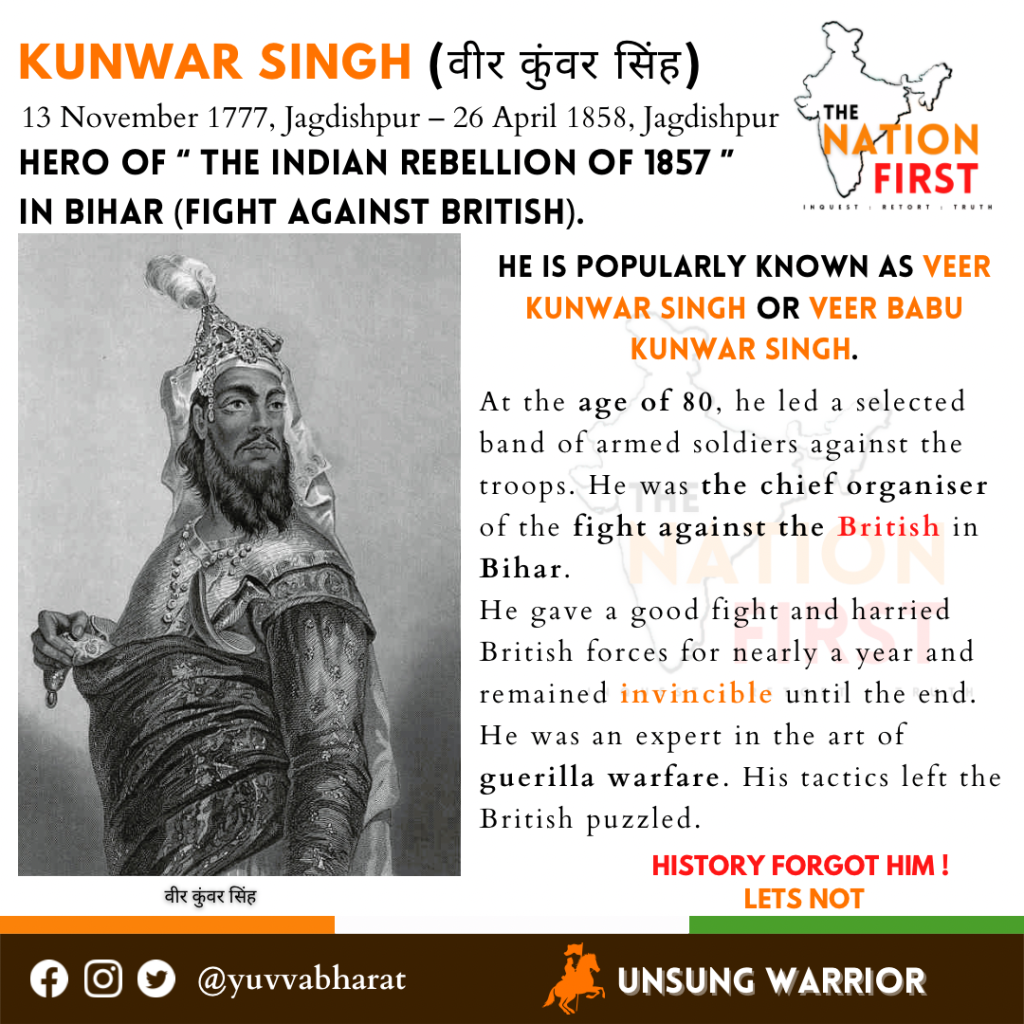Raja Kunwar Singh The Unsung Hero Of The 1857 Revolt
“80 बरस के उमर में जागा जोश पुराना था,
सब कहते हैं कुंवर सिंह बड़ा वीर मर्दाना था”

He was an Ujjaniya Rajput, brave leader at the age of 80 yrs old of Indian Revolt of 1857, fought against British Imperialism in Bihar & died a free man. Born in Rajput Royal house of Jagdighpur, Bihar, in 1777, Veer Kunwar Singh was the chief organizer of revolt against British occupation in Bihar.
Veer Kunwar Singh born in November 1777, to Maharaja Shabzada Singh and Maharani Panchratan Devi in Jagdishpur ( Bhojpur ) Bihar. He belonged to the Ujjaniya Rajput clan. He married the daughter of Maharaja Fateh Narayan Singh ( A Mewari Sisodiya Rajput ) and a descendant of the Great Maharana Pratap Singh of Mewar.
Rebellion against the British had broken out when a soldier called Mangal Pandey attacked a British sergeant and wounded an adjutant while his regiment was in Barrackpore. Veer Kunwar Singh led the rebellion of 1857 in Bihar. He was 80 years old when he was called upon to take up arms.
Singh gave a good fight and harried the British troops for a year. He was an expert in Guerilla warfare, His tactics left the British confused. Singh had assumed command of the soldiers who had revolted at Danapur in 25th July. Two days later he occupied Arrah, the District HQ. Major Vincent Eyre took Arrah on 3 August and ransacked Jagdishpur.
During the rebellion, Kunwar Singh’s troops had to cross the Ganga. Douglas’s army began to shoot at their boat and one of the bullets hit Singh’s left hand wrist. Concerned about the bullet wound and infection, Singh drew his sword and cut off his hand near the elbow and offered it to River Ganga.
In March 1858, Raja Kunwar Singh occupied Azamgarh ( UP), returned to his Palace and led a victorious battle near Jagdishpur on 23 April. The British led by Captain Le Grand were killed and defeated. He brought down the Union Jack & hoisted the Kesari Bhagwa. Raja Kunwar Singh passed away from his injuries on 26 April 1858.
Facts about Kunwar Singh
1. Kunwar Singh was born on November 1777 in a Zamindar family of the Ujjainiya clan of the Jagdishpur,Parmar Rajputs which is currently a part of Bhojpur district , Bihar , India. He was the son of Raja Shahabzada Singh and Rani Panchratan Kunwar Devi Singh.
2. Under the command of the British East India Company, he led a select band of armed soldiers against the troops. He was the chief organiser of the fight against the British in Bihar. Warriors like Nana Saheb , Rani Laxmibai , Tatya Tope and Begum Hazrat Mahal fought against the British in their respective regions.
3. The revolutionaries of Danapur, Bihar was also revolted on 25th July 1857 and gained control over there. Theserevolutionaries was leading by Veer Kunwar Singh. In comparison to the British, Kunwar Singh had limited resources but still he was not dissappointed and organized the revolutionaries.
4. He adopted the technique of Guerilla warfare and again defeated the Britishers. He got successful in causing damage to the public wealth of the British by his war policies. British officials called him as keen huntsman who love to enjoy horse-riding.
5. Just after the death of his father in 1826, he became the Taluqdar of Jagdishpur and got married to the daughter of Raja Fateh Narayan Singh, a rich zamindar of Gaya district. Kunwar singh proceeded from Jagdishpur to Guerilla warfare in the district of Ghazipur, Ballia, Azamgarh etc. and painted British as much as he can.
6. He also went to Banda , Rewa and Kanpur in many war campaign, meanwhile, the British received help from England and the rulers of princely states supported British. Due to non-commencement of the war the British got an opportunity to suppress the rebellion. In the fear of rebellion, British disarmed the Indian soldiers of the army and shoot them with cannons.
7. To honour his memory and his contribution to India’s freedom movement , the Republic of India issued a commemorative stamp on 23rd April 1966. There is also an university based on his name called Veer Kunwar Singh University, Arrah which was established in 1992. There is a bridge named Veer Kunwar Singh setu which was inaugurated in 2017 to connects north and south Bihar together. This setu is also known as Arrah-Chhapra Bridge. Some of the Bhojpuri singer mentioned him in their folk songs as a hero who fought against British oppression.
One such song is
अब छोड़ रे फिरंगिया! हमारऽ देसवा
लटपट कईले तुहुँ,
मजवा उड़ैले कैलास, देसपर।
जुलुम जोर शहर-गाँव लुटि,
फुनकी, दिहियात फिरंगिया, सुनी
सुनी कुंवर के बड़इयाँ में,
लागल अगिया, अब छोड़ रे फिरंगिया! हमार देसवा!
Another famous folk song based on Holi is very popular among the elderly people of rural Bihar. The lyrics goes like….
बंगला में उड़ेला गुलाल ए बाबू – बंगला में उड़ेला गुलाल,
ए हो बाबू कुँवर सिंह डेगवा बढ़ाएं – बंगला में उड़ेला गुलाल।।
Such thrilling tales of Kunwar Singh of Bihar are still alive in our folk songs-lores and has became immortal in history.


